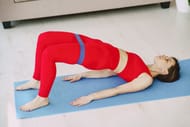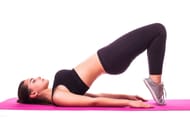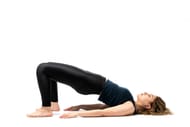The Supported Bridge pose (Setu Bandha Sarvangasana) is a beginner-level restorative backbend asana in yoga.
It helps strengthen the hips and legs, lengthens the spine and opens the heart. Regular practice of this yoga pose can help calm the mind and make the body energised, leaving you feeling refreshed and rejuvenated. This asana can be used as a part of the cool-down in a yoga session.
The Supported Bridge pose is considered a compound exercise that targets several groups of muscles, such as the triceps, biceps, hamstrings, hip flexors, glute muscles and quadriceps.
How to do Supported Bridge pose (Setu Bandha Sarvangasana) in yoga?
To do this effective yoga backbend, follow the following steps:

- Keeping your feet flat on the ground and knees bent, lie straight on your back on a yoga mat.
- Keep your arms on the ground with your fingers towards your heels. You should only barely touch your heels with your fingers.
- Make sure to keep your feet parallel, and maintain this position throughout the pose.
- Slowly press down on your feet, and lift your hips off the ground.
- You can also slide a yoga block under your back for support. Your arms can rest on the ground next to your body.
- Stay in this position for a few minutes as your body adjusts to the stretch. However, if your back starts to hurt, slowly remove the block, and come down.
- To come out of the pose, press down your feet, and raise your hips again.
- Lower your back gently to the floor.
Important Beginner Tips
Consider the following tips when doing this asana:
- Place a yoga block between your knees, and squeeze it as you lift your hips to activate your glutes and inner thigh muscles.
- If you have a weak back, try placing a block under your sacrum to get more support.
- Rest your weight on the block, and keep your knees at a hip-width distance.
Benefits of Supported Bridge pose (Setu Bandha Sarvangasana)
The Supported Bridge pose primarily helps improve your overall body posture and counteracts the impact of prolonged sitting.
It can also help prevent lower back pain and ease slouching and curving of the spine. This asana gently stretches your chest, shoulders and abdominal muscles while strengthening your glutes, ankles, back and thighs.

This pose works as a chest opener and also improves breathing. If you have chronic lower back pain, the Setu Bandha Sarvangasana might offer you great relief.
Additionally, this yoga pose targets the back, hips, core abdominals and hamstring muscles.
It specifically targets the obliques that help keep your lower back and pelvic floor muscles perfectly centred. The Supported Bridge asana allows your hamstrings to work during this pose, which helps stretch your hip flexors and quads as well.
Apart from these benefits, the Setu Bandha Sarvangasana offers some other benefits too, such as:
- Comforts the nervous system.
- Calms the body and mind.
- Eases symptoms of depression, anxiety and stress.
- Releases all the negative thinking and emotions from the body.
- Activates the chakras, including the Root Chakra or Muladhara, Throat Chakra or Visuddha.
Common Mistakes to Avoid

If you're placing a block under your sacrum, do not put it too centred on your lower back. Instead, place it right on your sacrum, located between your lower back and tailbone.
While the Supported Bridge pose (Setu Bandha Sarvangasana) is an effective yoga backbend, to reap its benefits, it's very important to perform the asana in the correct form. Be mindful of your posture; check your form when doing this yoga pose, and be consistent with your practice.
If you experience any discomfort or pain while performing the movement, come out of the pose. While this asana may help provide relief from chronic lower back pain, you should avoid it if you have ongoing lower back pain, or if you have had surgery or injury recently.
You should also avoid this yoga pose if you have any knee or neck problems. People with uncontrolled blood pressure issues, glaucoma, recent dental injuries, surgeries or detached retina should also not perform the Supported Bridge pose, as it's a backbend, and your head will get more blood flow.
